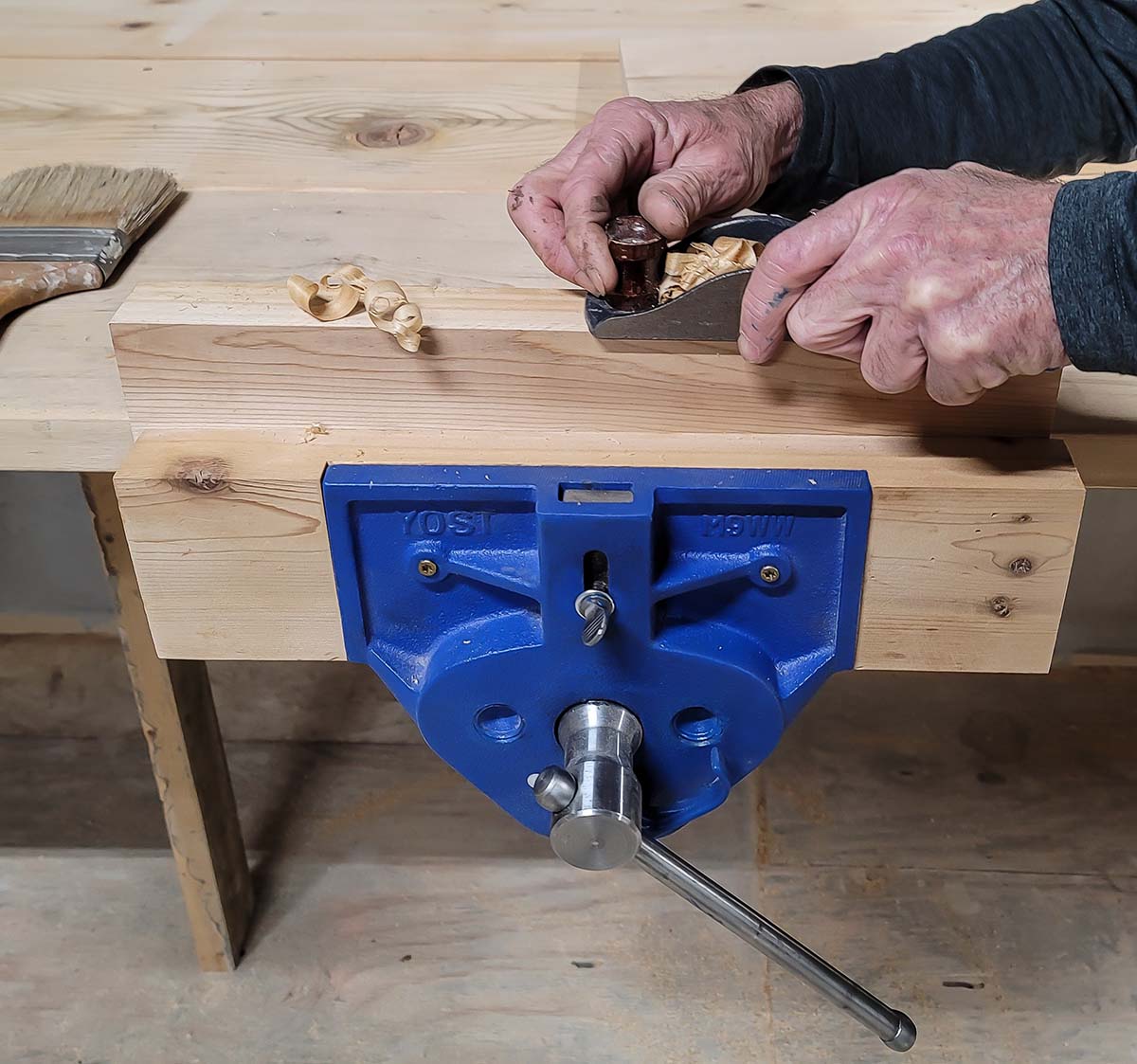We may earn revenue from the products available on this page and participate in affiliate programs. Learn More ›
All-purpose bench vises—the heavy cast-iron sort your grandfather might have had mounted on a bench in his garage—are handy for holding items such as bars, pipes, and axes. They are often used to grip such objects for welding, sharpening, and a host of other tasks, but they’re not great for woodworking since their serrated iron jaws tend to leave imprints in wood.
For furniture makers and DIY woodworkers, a designated woodworking vise is necessary because it holds boards and planks without leaving imprints. I recently tested the Yost Woodworking Vise along with several other types of bench vises. It performed well enough to earn a spot in our best bench vise lineup, and it deserves a more in-depth review here.
The Yost Woodworking Vise: At a Glance
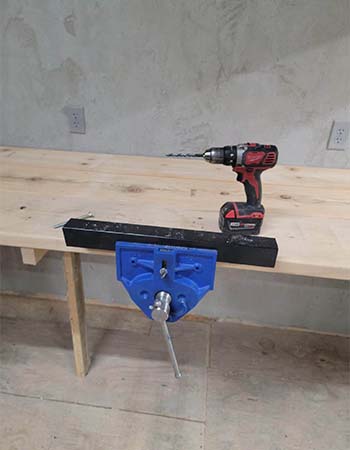
Rating: 8.95/10
PROS
- Comes with holes for attaching custom-fabricated wood jaw liners
- Features a quick-release lever that speeds jaw adjustment to save time
- Adjustable dog allows users to securely hold wider boards for sanding or planing
CONS
- Not suitable for heavy shop-type use due to its smooth jaw surfaces
- Mounting the woodworking vise requires installing bolts in the bottom of the workbench
- The bar handle is on the thin side and would benefit from being thicker
Get the Yost Woodworking Bench Vise at:
What is the Yost Woodworking Vise?
The Yost woodworking vise is a smooth-jaw vise designed for mounting to a workbench’s front edge (face) to securely hold boards while the user is cutting, sanding, or routing. Like most vises, it features two jaws that tighten via a screw handle. Its position at the front of the workbench allows users to perform woodworking tasks comfortably—no need to strain or lean over the bench to access the board.
The Yost woodworking vise is a 9-inch vise, meaning the width of its steel jaw plates measures 9 inches from side to side. It opens to a max of 10.25 inches, making it well suited for holding large boards. In addition to adjusting the jaws with the screw handle, I appreciated the vise’s quick-release lever, which allowed me to quickly pull the jaws apart or push them together. This is a time-saver. I used the lever to move the jaws to the approximate spot—and then it took just one or two turns of the screw handle to fine-tune the jaw position.
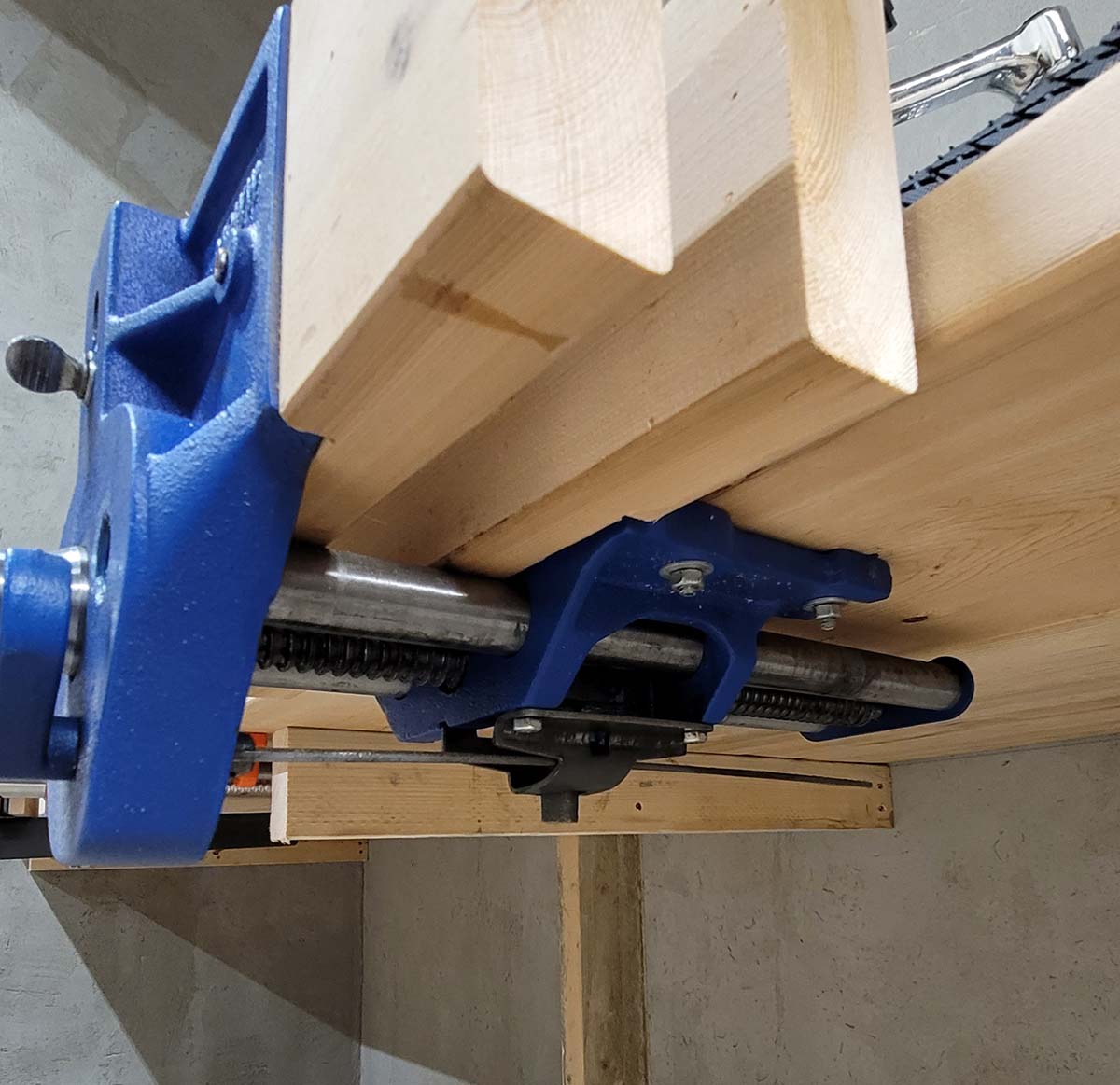
What is involved in installing the vise?
The vise didn’t come with bolts, which is to be expected because manufacturers don’t know the thickness of the bench users will be bolting the vise to—and some users may prefer specific bolts. I chose 5/16-inch carriage bolts because I didn’t want the heads of the bolts to stick up above the workbench’s surface. Carriage bolts are designed for countersinking, so they’re a good option to prevent obstructions on the surface of the workbench.
It wasn’t difficult to install the Yost vise—it takes just four bolts to secure the vise’s screw mechanism to the underside of the bench. I turned the vise upside down in the spot where I wanted to mount it, marked the four holes with a pencil, and then drilled top-down holes. This is the simplest way to mount the vise, and it works great. The alternative—trying to hold the vise on the underside of the bench and drill from the bottom—is much more complicated, and it’s unnecessary.
I then inserted the carriage bolts down through the holes and positioned the vise on the underside of the workbench. The bolts fit perfectly. I twisted nuts on the bolts and tightened them with a socket wrench. The tightening process draws the heads of the carriage bolts downward so they don’t extend above the workbench surface. After it was installed, the vise was ready to start testing.
Will the Yost vise leave imprints on wood?
The difference between an all-purpose vise and the Yost woodworking vise lies in the design of its jaw plates. Unlike an all-purpose vise that features serrated jaws for gripping pipes and steel items, a woodworking vise comes with smooth jaws that are less likely to damage boards.
I tightened several long and short oak, pine, and cedar boards in the vise. I cranked hard on the screw handle to put as much pressure as possible on the boards—more force than I would typically use to hold them for routing or cutting. When I released the jaws, the only board that came away with a very faint imprint was the cedar board, which is a pretty soft wood. The oak and pine boards did not show any imprinting.
The Yost’s design provides extra insurance against imprinting—it comes with holes inside its jaw plates for attaching custom jaw liners. I fabricated my own set of jaw liners from 16-inch-long cedar boards. Then, using bolts, I attached one inside each jaw. With my jaw liners in place, I put another cedar board in the vise and tightened it as much as possible. When I released the jaws, there were no imprints at all. Making your own jaw liners is optional, but most professional woodworkers use them because they add another level of protection for the wood.
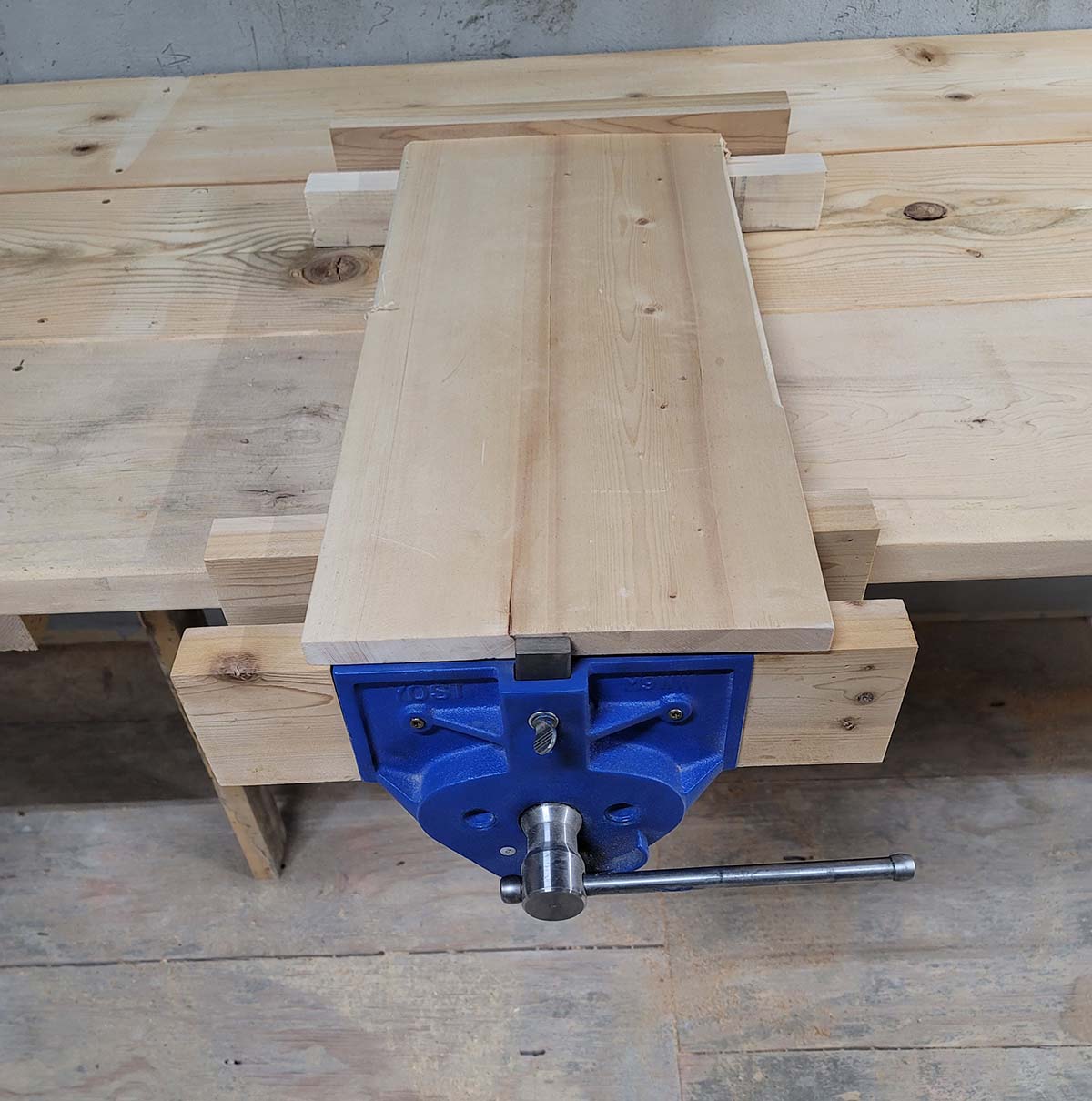
Is the Yost vise suitable for uses other than woodworking?
The Yost bench vise can be used in a pinch to hold other materials as long as the materials have flat sides. I used it to clamp a section of square metal railing, and the vise held firm as I drilled holes in the metal.
I would avoid trying to clamp irregular-size items, such as round pipes that could damage the jaw’s smooth surface if the vise is overtightened. In our more extensive bench vise tests, we used several all-purpose vises to hold pipes while we twisted off stuck-on fittings with a wrench. That’s probably too aggressive a use for this woodworking vise.
But I wouldn’t hesitate to use it for light-duty gripping, such as holding other flat objects like sheet metal, drywall, or plastic panels for cutting or shaping.
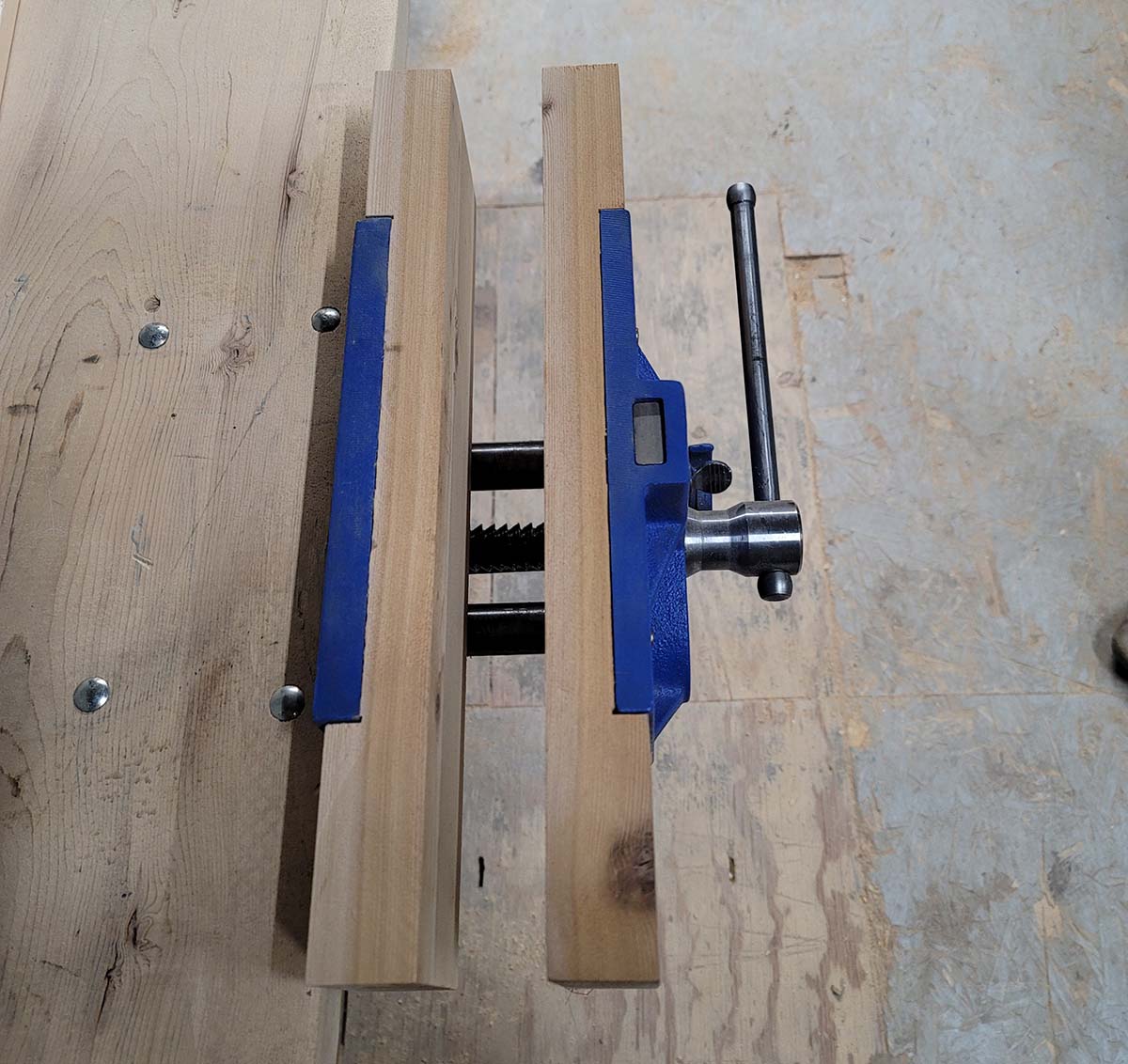
Is the Yost woodworking vise suitable for larger projects?
The Yost vise isn’t designed for heavy-duty use, so don’t expect it to hold large timbers. However, users can secure boards wider than the maximum jaw opening by using the adjustable dog in the vise’s outer jaw. A “dog” is woodworker lingo for something extra that helps secure the board in place. On the Yost vise, the dog is an adjustable steel bar that extends upward. It’s designed to be used with a bench stop (not included).
I built a simple bench stop by screwing down a block of wood to the center of my workbench, and then I positioned a wide, flat board between the bench stop and the dog. With a few cranks of the vise’s handle screw, I could snug the board firmly between the dog and the stop while I routed the board’s edges and sanded it.
Is the Yost woodworking vise right for you?
Those looking for a vise for a wood shop will likely be satisfied with the Yost woodworking vise. I found it sturdy, durable, and versatile enough to fulfill most of the uses I have for a woodworking vise. It’s not a mechanic’s vise, so don’t expect it to do double duty. Its strength lies in holding most types of wood while keeping them free from unwanted imprints and marring.
The ability to add custom-fabricated wood jaw liners puts it over the top and turns it into a professional woodworker’s tool, and the quick-release lever is a boon for saving time. For me, the most versatile plus was Yost’s adjustable dog, which allowed me to hold wide boards firmly between the dog and the bench stop.
Where to Buy the Yost Woodworking Bench Vise
Get the Yost Woodworking Bench Vise at:
Meet the Tester
Glenda Taylor is a product tester and writer specializing in the construction, remodeling, and real estate industry. She and her husband own a general contracting company, and Taylor is experienced in both residential and commercial building applications. She tests a wide range of power tools as well as other home improvement, household, and lawn-and-garden products.

